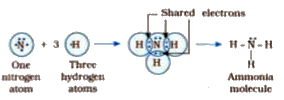Explain the formation of covalent bonds in ammonia molecule (NH3).
Text Solution
Nitrogen is a central atom in the molecule of ammonia. The atomic number of nitrogen is 7, so its electronic configuration is KL25
Thus, nitrogen has five electrons in its L shell.
Therefore, it needs three more electrons to fill the L shell.
Nitrogen shares three of its valence electrons with one electron each of K shell of three hydrogen atoms to form a molecule of ammonia (NH3).
As a result, nitrogen atom of ammonia attains the electronic configuration of its nearest noble gas neon (Ne), which has eight electrons in its L shell, while hydrogen atom attains the electronic configuration of its nearest noble gas helium (He), which has two electrons in its K shell.
Here, these valence electrons are depicted by dots or crosses is shown as follows:

|
Topper's Solved these Questions
- CARBON AND ITS COMPOUNDSBOOK - KUMAR PRAKASHANCHAPTER - CARBON AND ITS COMPOUNDSEXERCISE - ACTIVITY
22 Videos
- CARBON AND ITS COMPOUNDSBOOK - KUMAR PRAKASHANCHAPTER - CARBON AND ITS COMPOUNDSEXERCISE - TEXTUAL EXERCISE
14 Videos
- ACID , BASES AND SALTBOOK - KUMAR PRAKASHANCHAPTER - ACID , BASES AND SALTEXERCISE - Activity
47 Videos
- CHEMICAL REACTIONS AND EQUATIONS BOOK - KUMAR PRAKASHANCHAPTER - CHEMICAL REACTIONS AND EQUATIONS EXERCISE - PRACTICAL SKILL BASED QUESTIONS WITH ANSWERS
5 Videos
Similar Questions
Knowledge Check
The number of covalent bonds in NH3 is
A1B2C3D4
Find the mass (in kilogram) of an ammonia molecule NH3.
View SolutionFind the mass (in kilogram) of an ammonia molecule NH3.
View SolutionWhat is the total number of covalent bonds in a molecule of ammonia?
View SolutionExplain the following:
Ammonia is polar covalent molecule.
View SolutionExplain formation of covalent bond by the electron structure of hydrogen, oxygen and nitrogen molecules.
View SolutionExplain the nature of the covalent bond using the bond formation in CH3Cl.
View SolutionExplain the nature of the covalent bond using the bond formation in CH3Cl.
View Solution
